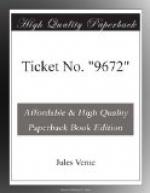As for Hulda, her anxiety on the subject was no less serious, for fashions are pitiless, and give, besides, not a little trouble in the selection of their wedding-toilet.
Hulda would now be obliged to abandon the long plaits tied with bright ribbons, which had heretofore hung from under her coquettish cap, the broad belt with fancy buckles that kept her apron in place upon her scarlet skirt, the girdle to which were appended several small embroidered leather cases containing a silver tea-spoon, knife, fork, needle-case and scissors—articles which a woman makes constant use of in the household.
No, on the fast approaching day of the nuptials, Hulda’s hair would be allowed to float down upon her shoulders, and it was so abundant that it would not be necessary for her to have recourse to the jute switches used by Norwegian girls less favored by nature. Indeed, for her clothing, as well as for her ornaments, Hulda would only be obliged to resort to her mother’s big chest. In fact, these articles of clothing are transmitted from marriage to marriage through all the different generations of the same family. So one sees reappearing again and again upon the scene the bodice embroidered in gold, the velvet sash, the skirt of striped silk, the gold chain for the neck, and the crown—the famous Scandinavian crown—carefully preserved in the most secure of all the chests, and made of pasteboard covered with embossed gilt paper, and studded with stars, or garlanded with leaves—that takes the place of the wreath of orange-blossoms worn by brides in other European countries.
In this case the crowned betrothed, as the bride is styled, would certainly do honor to her husband; and he would be worthy of her in his gay wedding suit: a short jacket trimmed with silver buttons, silk-embroidered waistcoat, tight breeches fastened at the knee with a bunch of bright ribbons, a soft felt hat, yellow top-boots, and in his belt the Scandinavian knife—the dolknife—with which the true Norwegian is always provided.
Consequently, there was plenty to occupy the attention of the young ladies for some time to come. Two or three weeks would barely suffice if they wished to have everything in readiness before Ole’s return; but even if Ole should arrive sooner than he expected, and Hulda should not be quite ready, she would not be inconsolable, nor would he.
The last weeks of April and the first weeks of May were devoted to these matters. Joel assumed charge of the invitations, taking advantage of the fact that his vocation of guide gave him considerable leisure at this season of the year. One would have supposed that he had a large number of friends in Bamble, for he went there very often. He had already written to Help Bros., inviting them to attend his sister’s wedding, and in accordance with his prediction, these worthy shipowners had promptly accepted the invitation.
The fifteenth of May came, and any day now they might expect Ole to alight from his kariol, throw open the door, and shout in his hearty, cheerful voice:




